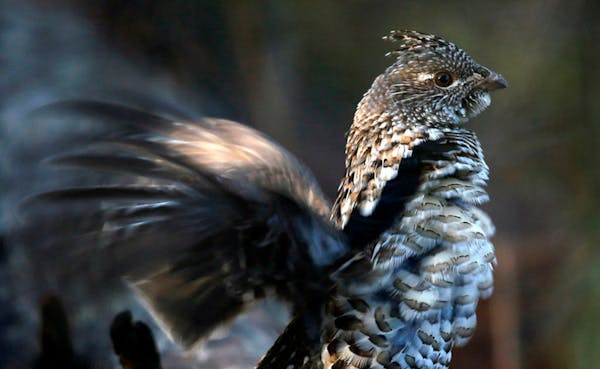It didn't take long for chronic wasting disease (CWD) to rear its ugly head in this year's Minnesota deer hunt.
On opening weekend for archers, a hunter in southeastern Minnesota harvested a 3-year-old buck 1 mile east of Preston that tested positive for the neurological disease. The deer, which appeared healthy, was among the first 15 animals this season to be screened for CWD by the Department of Natural Resources (DNR).
The finding, announced Monday, renewed public attention on the state's ongoing, multifaceted fight against the spread of CWD. Thousands of more deer will be sampled, the state has banned deer feeding in widespread areas, wildlife officials are studying the roamings of radio-collared deer and DNR conservation officers have intensified efforts to stop hunters from transporting carcasses of potentially infected deer.
"We're not off to a great start, but hopefully it'll be few and far between,'' Taylor Bestor, president of Bluffland Whitetail Association, said of the sudden CWD case in Fillmore County.
Bestor said the DNR issued a new buck tag to the hunter who arrowed the diseased buck — a positive gesture for the sake of hunter cooperation.
Bestor said his nonprofit conservation organization is supporting a DNR mandate for hunters inside the southeastern CWD management area (Zone 603) to quarter their deer before taking it home. The group, formed by bow hunters in southeastern Minnesota, recently installed a fully enclosed tent near the Fillmore County sheriff's office in Preston. The quartering station, complete with a hoist, saws and knives, includes instructions on how to break down a registered harvest to avoid spreading disease-causing prions located in spinal and brain tissue.
"We put this on our Facebook page and we've had 7,000 views,'' Bestor said. "People are using the tent.''
All spinal and brain tissue must be left behind in dumpsters provided by the state.
Similarly, the DNR is now enforcing a ban against the importation of deer carcasses from other states. The agency has updated its public information campaign to teach hunters how to remove venison from a deer's body in order to safely and legally bring it home from another state, free of prions. The misshaped proteins can persist in the environment and infect healthy deer. More than 40 other states have similar bans.
DNR Wildlife Research Manager Lou Cornicelli said no one wanted to see another case of CWD in Minnesota, but he said Monday's news would have been worse if the deer were located out the vicinity of the outbreak. The main hot spot is east of Preston and west of Lanesboro.
The tissue sampling test that detected the latest case is mandatory for all deer harvested in Zone 603. The area covering Fillmore County and its fringes was designated three years ago by the DNR. Since the fall of 2016, 18 deer harvested in the zone have now tested positive for disease. It's the only ongoing CWD outbreak known within the state, but surveillance will be added soon in three additional areas.
Cornicelli said Minnesota's firearms deer season will provide the bulk of this year's surveillance for the disease. Archers account for only 10 percent of the annual whitetail harvest in the state. When some 450,000 hunters join the hunt with firearms starting on Nov. 3, the DNR will impose mandatory CWD testing in three additional regions: southeastern hunting zones outlying Zone 603; a cluster of north-central hunting zones north of Brainerd and a wide area in central Minnesota north of Hutchinson and south of Kimball.
The central and north-central surveillance areas will test whether CWD has escaped private deer farms where outbreaks of the disease have occurred in captive herds. The goal is to test 500 deer in each of those areas and another 3,150 whitetails from all over the Southeast.
Bestor said DNR's aggressive response to CWD — costing about $1 million a year — has been welcomed by many hunters who believe the disease can be slowed or stopped. But in southeastern Minnesota, generally regarded as the best place in the state to hunt deer, not everyone is happy, he said.
Disgruntled hunters believe the DNR has gone too far in reducing the region's wild herd. For one, the agency set aside relatively new antler point restrictions that had increased the abundance of big bucks. Now it's legal to harvest any buck and Zone 603 hunters may harvest an unlimited number of antlerless deer. The agency also expanded the harvest in other ways and previously brought in federal sharpshooters — all to thin the herd.
CWD is contagious among deer. Wildlife officials believe they can curtail the disease by sharply reducing deer populations where there's an outbreak.
Cornicelli said the DNR also is proceeding with its movement study of deer captured last year inside the CWD zone. The agency is reminding hunters not to pass on a deer just because it's wearing a radio collar. The study is meant to inform wildlife biologists on mortality factors and potential paths that the disease might follow, away from the CWD zone.
Already this season, a bow hunter harvested a study-collared deer near the town of Leroy on the Iowa border. Cornicelli said the deer was collared within a mile of where it was harvested.

Vikings draft QB J.J. McCarthy, edge Dallas Turner
2024 NFL Draft: List of first round picks
76ers All-Star center Joel Embiid says he's suffering from Bell's palsy
NFL Draft Latest: Caleb Williams to Bears, record six QBs taken in first 12 picks

